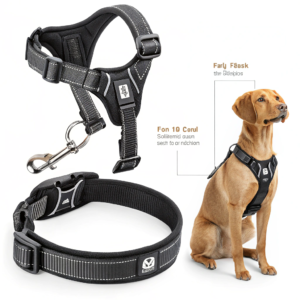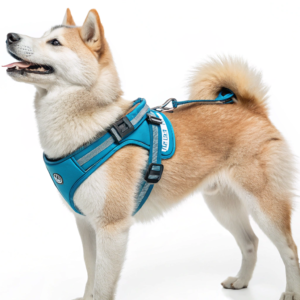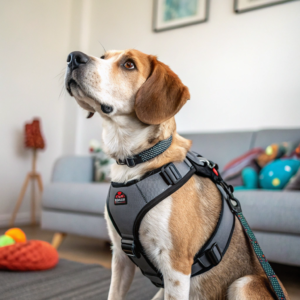Which is better dog harness or collar?
Walking your dog should be enjoyable, not a struggle. Many pet owners face the dilemma of choosing between harnesses and collars, unsure which offers better control and comfort for their furry friend.
**For most dogs, harnesses are better than collars because they reduce strain on the neck, provide better control, and prevent potential For most dogs, harnesses1 are better than collars because they reduce strain on the neck, provide better control, and prevent potential tracheal damage

I’ve tried both options with my dogs over the years, and I’ve learned that the right choice depends on your dog’s size, behavior, and health needs. Let’s explore the differences to help you make the best decision for your four-legged companion.
Is it better for a dog to have a collar or harness?
Many dog owners struggle with this choice daily. Collars seem simpler, but harnesses offer better control and may be safer for certain dogs with neck or respiratory issues.
**Harnesses are generally better for dogs with Harnesses are generally better for dogs with respiratory issues, short noses1 (like Pugs or Bulldogs), or those prone to pulling
Let me break this down further based on my experience fitting thousands of dogs with the right walking equipment. The decision between a collar and harness isn’t just about preference—it’s about your dog’s health and your walking experience.
When to Choose a Collar
Collars work well in several situations:
- Well-trained dogs: If your dog walks nicely on leash without pulling, a collar is perfectly suitable
- ID tag placement: Collars are great for holding identification tags
- Simplicity: They’re easier to put on and take off
- All-day wear: Dogs can comfortably wear collars all day
However, collars can cause serious issues for some dogs. When a dog pulls on a collar, it puts pressure on the trachea (windpipe), thyroid gland, and When a dog pulls on a collar, it puts pressure on the trachea1 (windpipe), thyroid gland, and cervical vertebrae
When to Choose a Harness
Harnesses distribute pressure across the chest and back rather than concentrating it on the neck. They’re ideal for:
| Dog Type | Benefit of Harness |
|---|---|
| Puppies | Protects developing trachea and neck |
| Brachycephalic breeds | Reduces respiratory strain |
| Dogs with neck injuries | Eliminates pressure on sensitive areas |
| Escape artists | More secure than collars |
I’ve noticed that many clients report their dogs seem more comfortable and relaxed in properly fitted harnesses. The key word here is "properly fitted" – a harness that’s too tight can cause chafing, while one that’s too loose might allow escape.
What is the best option for a dog that pulls?
The frustration of being dragged down the street by an enthusiastic puller is real. Many owners resort to yanking back on the leash, but this can hurt your dog and damage your relationship.
**For dogs that pull, a front-clip harness is the best option as it redirects the dog’s momentum to the side when they pull, For dogs that pull, a front-clip harness1 is the best option as it redirects the dog’s momentum to the side when they pull, reducing pulling behavior

I’ve worked with many clients whose arms were nearly pulled out of socket by their enthusiastic dogs. Finding the right equipment made all the difference in their walking experience.
Types of Anti-Pull Harnesses
There are several effective designs for dogs that pull:
-
Front-clip harnesses – These have the leash attachment point on the dog’s chest. When the dog pulls, the harness causes them to turn toward you rather than continuing forward. The gentle redirection discourages pulling without causing pain.
-
Dual-clip harnesses – These versatile options have attachment points on both the chest and back, giving you flexibility depending on the situation.
-
Y-shaped harnesses – These follow the natural contours of a dog’s muscles and allow free shoulder movement.
I recommend avoiding:
- Back-clip only harnesses for strong pullers (they can actually enable pulling behavior)
- "No-pull" harnesses that work by causing discomfort or restricting movement
A good pulling solution should be comfortable for your dog while providing you with control. I’ve seen transformations in walking behavior simply by switching to the right harness and combining it with positive reinforcement training.
Training Component
It’s important to note that no harness is a magical solution. The equipment is just a tool to help manage pulling while you work on training. Consistent positive reinforcement when your dog walks nicely will yield the best long-term results. I always tell my clients: "The harness buys you time to train."
What are the disadvantages of dog harness?
While harnesses solve many problems, they’re not perfect. Some dogs resist wearing them, and putting them on can be a struggle, especially with wiggly puppies or dogs unaccustomed to wearing gear.
**The main disadvantages of The main disadvantages of dog harnesses include more complicated fitting and adjustment, potential for chafing1 if improperly sized, higher cost than collars, and possible reinforcement of pulling behavior with back-clip models

I’ve encountered many harness-related issues in my years of working with dogs, and most stem from improper fit or selection. Understanding these disadvantages can help you make better choices for your particular dog.
Common Harness Problems and Solutions
-
Proper Fitting Challenges
Harnesses come in many styles and sizes, making proper fitting more complex than collars. A poorly fitted harness can cause discomfort, chafing, or even allow escape.
I recommend taking your dog for in-person fitting when possible. Look for harnesses with multiple adjustment points that allow customization to your dog’s unique body shape. The general rule is you should be able to fit two fingers between the harness and your dog’s body at any point.
-
Restriction of Movement
Some harnesses, particularly those with horizontal straps across the shoulders, can restrict natural movement. This is especially problematic for athletic dogs.
Solution: Choose Y-shaped or H-shaped harnesses that follow the natural contours of your dog’s body and keep the shoulder area free from straps.
-
Training Implications
Back-clip harnesses can actually train dogs to pull harder due to the opposition reflex (when pressure is applied, dogs naturally pull against it).
Harness Type Effect on Pulling Back-clip only May encourage pulling Front-clip Discourages pulling Dual-clip Versatile control options -
Skin Irritation and Matting
Harnesses can cause rubbing, especially in dogs with sensitive skin or long fur. Long-haired dogs may experience matting under harness straps.
I suggest removing the harness when not in use and checking for signs of irritation regularly. For long-haired breeds, consider harnesses with padded straps to minimize friction.
Conclusion
Both harnesses and collars have their place in dog walking. For most dogs, especially puppies, pullers, and short-nosed breeds, harnesses provide safer control. The best choice depends on your unique dog’s needs and your training goals.
-
Exploring ways to prevent chafing can enhance your dog’s experience and ensure they are comfortable while wearing a harness.
include more complicated fitting and adjustment, potential for chafing if improperly sized, higher cost than collars, and possible reinforcement of pulling behavior with back-clip models. Some dogs also find harnesses more restrictive or uncomfortable initially.** ↩ ↩ ↩ ↩ ↩

